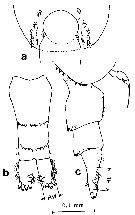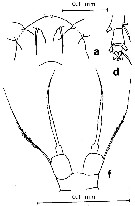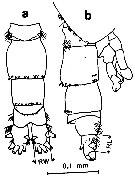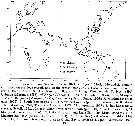|
|
 |
Fiche d'espèce de Copépode |
|
|
Calanoida ( Ordre ) |
|
|
|
Diaptomoidea ( Superfamille ) |
|
|
|
Acartiidae ( Famille ) |
|
|
|
Acartia ( Genre ) |
|
|
|
Acanthacartia ( Sous-Genre ) |
|
|
| |
Acartia (Acanthacartia) plumosa T. Scott, 1894 (F,M) | |
| | | | | | | Syn.: | no Acartia plumosa : Brodsky, 1948; 1950 (1967) (p.424, figs.F,M); Sewell, 1932 (p.395); 1934 (p.80); Wellershaus, 1969 (part., p.271, figs.M, no F, Table 3); Abraham, 1970 a (p.115, figs.F,M); Tranter & Abraham, 1971 (p.224, figs. 2Af, 2Bf) | | | | Ref.: | | | T. Scott, 1894 b (p.66, figs.F,M); Giesbrecht & Schmeil, 1898 (p.153); Steuer, 1923 (p.24, figs.F,M); Sewell, 1932 (p.395); Marques, 1953 (p.122, figs.F); Vervoort, 1965 (p.197, Rem.); Abraham, 1970 (p.52, Rem.); Greenwood, 1972 (p.317, Rem.); Goswami & Goswami, 1973 (p.242, fig.1, karyotypes); Ueda & Hiromi, 1987 (p.226, 230, 235, Redescr., figs.F,M, Rem.); Bradford-Grieve & al., 1999 (p.886, 962, figs.F,M). |  issued from : H. Ueda & J. Hiromi in Crustaceana, 1987, 53 (3). [p.227, Fig.2, a-c]. Female (from Pointe Noire, SE Atlantic): a, posterior metasome, b-c, urosome (dorsal and lateral, rspectively). Nota: Posterior corner of metasome rounded, on each side with 2 rows of conical spines and 1 fine hair laterally; medially with numerous minute spinules; Spines of outer row at 5 loci, each locus with 0-4 (usually 1 or 2) spines; spines of inner row smaller than those of outer and arranged in 2 groups, 7-13 smaller dorsal spines and 2-7 larger ventral spines. Genital segment with 7-10 spines on posterodorsal margin and 3 rows of very minute hair-like spinules on ventral surface, lateral surface without spinules. 2nd urosomal segment with 6-13 posterodorsal spines. Anal segment with ventrolateral hairs. Caudal rami as long as urosomal segment 2, asymmetrical with dorsal seta of right ramus more distally located than that of left; RL/RW 1.5-1.7; lateral and distomedial margins fringed by hairs.
|
 issued from : H. Ueda & J. Hiromi in Crustaceana, 1987, 53 (3). [p.228, Fig.3, d, f]. Female: a, forehead (ventral); d, right A1 (15th-17th segments); f, P5 (anterior view). Nota: A1 17-segmented, extending beyond last metasomal segment; 16th segment with a row of spinules on ventral surface. P: distal two-thirds of spine with dentate inner and outer margins.
|
 issued from : H. Ueda & J. Hiromi in Crustaceana, 1987, 53 (3). [p.229, Fig.4, a-b]. Male: a, urosome (dorsal); b, posterior metasome with P5 and urosome (lateral). Nota: Caudal rami RL/RW 0.9-1.0. Right A1 18 segmented, with geniculation between 14th and 15th segments; left A1 21-segmented.
|
 issued from : H. Ueda & J. Hiromi in Crustaceana, 1987, 53 (3). [p.231, Fig.5, a]. male: a, P5 (anterior view).
|
 issued from : H. Ueda & J. Hiromi in Crustaceana, 1987, 53 (3). [p.235, Table I]. Comparative list of characters in the Acartia plumosa - sinjiensis - tropica species group.
|
 issued from : A. Steuer in Arb. zool. Inst. Innsbruck, 1923, 1 (5). [p.24, Figs.110-114]. Female: 110, habitus (dorsal); 111, last thporacic segment and urosome (dorsolateral); 113, P5. Male: 112, urosome (dorsal); 114, P5, after T. Scott, 1894.
|
 issued from : A. Steuer in Arb. zool. Inst. Innsbruck, 1923, 1 (5). [Taf. II, Figs.13, 14]. Female: 13, genital segment (lateral; 14, idem (ventral).
|
 Issued from : S. Wellershaus in Veröf. Inst. Meeresf. Bremerhaven, 1969, XI. [p. 271, Figs. 71, 72]. Female (from Cochin Backwater, area between outlet and Aroor Bridge): 71, last thoracic segtment wit P5 and urosome (abdomen dorsolateral, caudal rami dorsal); 72, P5 (A: terminal spine lateral, B: posterior, C: detail). Scale bars: single = 100 µm; doble = 50 µm. Nota; - Ratio prosome : urosome = 3.45. - No spines on A1 except the spine on egment 7-8. - Anal operculum without spines. - Caudal rami: length : breadth = 12.5 : 5.0.
|
 Issued from : S. Wellershaus in Veröf. Inst. Meeresf. Bremerhaven, 1969, XI. [p. 272, Table 3]. Comparative list of characters in the Acartia plumos-chilkensis-Group.
| | | | | Ref. compl.: | | | Sewell, 1948 (p.324, 431); Neto & Paiva, 1966 (p.28, Table III); Binet & al., 1972 (p.71); Dessier, 1979 (p.133, 201, 207); Ueda & al., 1983 (p.165, Table 1, 2, 3, 4, swarms); Brenning, 1985 a (p.16, 28, Table 2); Madhupratap & Haridas, 1986 (p.105, tab.2); Brenning, 1987 (p.34, Rem.); Diouf & Diallo, 1987 (p.260); Marcus, 1996 (p.143, as pulmosa); Mauchline, 1998 (tab.8); Madhu & al., 2007 (p.54, Table 4, abundance vs monsoon); Labat & al., 2009 (p.1747, Table 2); Trottet & al., 2017 (p. 7, Table 3: resting stage, as A. pulmosa) | | | | NZ: | 4 + 1 douteuse | | |
|
Carte de distribution de Acartia (Acanthacartia) plumosa par zones géographiques
|
| | | | | |  Carte de 1996 Carte de 1996 | |
 issued from : H. Ueda & J. Hiromi in Crustaceana, 1987, 53 (3). [p.232, Fig.6]. issued from : H. Ueda & J. Hiromi in Crustaceana, 1987, 53 (3). [p.232, Fig.6].
Distribution of the three species A. plumos, A. sinjiensis, A. topica. |
| | | | Loc: | | | Angola, Baia Farta, Congo, G. of Guinea, Ivorian shelf, Casamance, Mauritania, Azores-Portugal (in Labat & al., 2009), Indian (Sud Yemen, Mandovi-Zuari estuary, Cochin, Kerala, Salt Lakes), Singapore (in Trottet & al., 2017), ? Japan (Inland Sea).
Species type: from Congo mouth. | | | | N: | 17 | | | | Lg.: | | | (16) F: 1,15-1,08; (75) F: 1,21-1,14; M: 1,13-1; (93) F: 1,16-1,09; M: 1,05-1,01; (164) F: 1,18-1,17; (232) F: 1,1-0,9; M: 1-0,85; (1110) F: 1,2-1,3; {F: 0,90-1,30; M: 1,0-1,13} | | | | Rem.: | Forme ± saumâtre, estuaire; épipélagique.
La répartition géographique est peu claire du fait de la confusion avec Acartia tropica et Acartia sinjiansis.
Voir aussi les remarques en anglais | | | Dernière mise à jour : 25/02/2020 | |
|
|
 Toute utilisation de ce site pour une publication sera mentionnée avec la référence suivante : Toute utilisation de ce site pour une publication sera mentionnée avec la référence suivante :
Razouls C., Desreumaux N., Kouwenberg J. et de Bovée F., 2005-2025. - Biodiversité des Copépodes planctoniques marins (morphologie, répartition géographique et données biologiques). Sorbonne Université, CNRS. Disponible sur http://copepodes.obs-banyuls.fr [Accédé le 14 octobre 2025] © copyright 2005-2025 Sorbonne Université, CNRS
|
|
 |
 |













